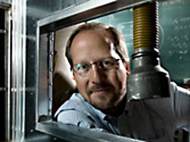CleanAir indoor climate chemical system saves energy
 A new invention could cut energy use in buildings by 25 percent by creating a better indoor climate. The CleanAir invention was recently patented by a researcher in atmospheric chemistry at the University of Copenhagen. The inventor, Matthew Johnson, has shown his invention to the general public for the very first time at the conference “World Climate Solutions” at Bella Center in Copenhagen on 29-30 September.
A new invention could cut energy use in buildings by 25 percent by creating a better indoor climate. The CleanAir invention was recently patented by a researcher in atmospheric chemistry at the University of Copenhagen. The inventor, Matthew Johnson, has shown his invention to the general public for the very first time at the conference “World Climate Solutions” at Bella Center in Copenhagen on 29-30 September.
Heating, cooling and dehumidifying air in buildings currently consumes one sixth of all the energy used in the world. Johnson‘s CleanAir system is able to cut building energy use by up to 25%. Aside from lowering bills and lessening resource consumption and CO2 emissions, this system is also about securing better health.
The invention might prove beneficial for asthmatics, the allergic, the elderly and children. Lab tests have proven that the device removes particles, viruses, ozone, bacteria, organic solvents and hydrocarbons from air. Even cigarette smoke is neutralized by the patented invention. In a real-world test 40 different compounds were removed from a new office building at the University of Copenhagen within minutes of switching on the device.
Professor Matthew Johnson came up with the idea for his groundbreaking invention while investigating how pollution is removed from the atmosphere by natural processes. He realized that these processes could be brought into buildings and be used to clean the air in our homes and offices. And this would save energy.
“Every second we pump air into our houses that is too hot, too cold or too moist. And then we spend billions of kilowatts treating that air; cooling it, heating it or dehumidifying it. If we could clean the air, we could recycle air that already has the perfect temperature”, said Johnson.
While real world tests have already proven that cleaner office air could save millions of tons of CO2, the CleanAir invention has the potential for even bigger health benefits. It might clean industrial air as well. Professor Matthew Johnson is planning to investigate how well the device could remove VOC (Volatile Organic Compounds) from industrial smokestacks. If this idea works, it will revolutionize the cleaning of emissions from factories.









Leave your response!